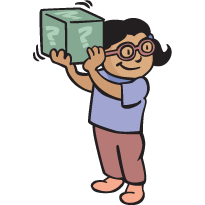Boston Children's Museum
308 Congress Street, Boston, MA 02210
617-426-6500
© Boston Children’s Museum 2025
Website Design by JackrabbitChildren’s bodies are undergoing constant change. By getting to know their own bodies better, these changes can be less mysterious. Children who are in tune with their own bodies can use all of their senses as tools as they explore and try to understand the world around them. This activity helps children learn more about their sense of touch, along with properties of objects, observation and descriptive vocabulary.
Using the following instructions, make at least 1 Mystery Box ahead of time. In the side of a large cardboard box, cut a hole big enough for your students to stick their hands through. Inside the box, tape, glue or staple a piece of fabric over the hole, creating a “curtain”. Only tape, glue or staple the top of the curtain—you want kids to be able to push it aside as they reach their hands into the box. If you have the resources, make several boxes, 1 for each team. Smaller boxes (like shoe boxes) and smaller objects can be used if you’re making many boxes. If you’re making only 1 large box, you could create 4 holes, 1 on each side, so that more than 1 child can reach in at the same time. Collect several objects for placing in the box. Make them things that your students are familiar with – a glove, a shoelace, a crayon, an apple, a rock, etc.

Ask your students what it might be like to feel their way through the dark. How could they tell where they are? Have they ever tried finding a light switch in the dark? Was it easy or hard to do?
Figure out what is hiding in the “Box of Mystery” just by using your sense of touch!
After 5–10 minutes of activity, when every team has had a student guess an object, bring them together to share their observations with each other. Was it easy or hard to guess what their object was? Were some objects harder to figure out than others? This discussion should last no more than a few minutes.
Give every child a chance to guess what’s in the Mystery Box (make sure to hand out new objects for each new Guesser).